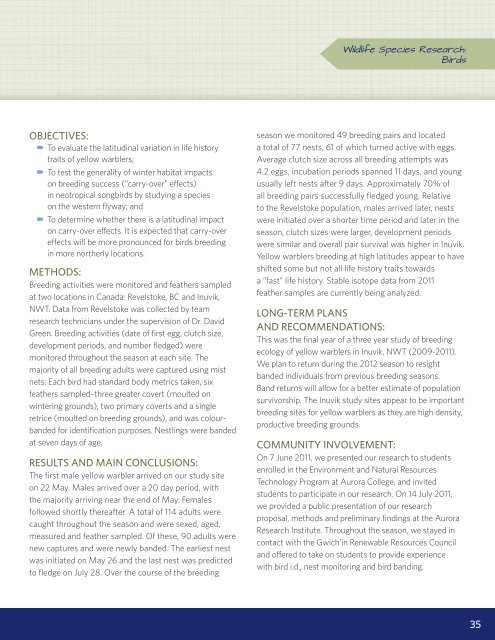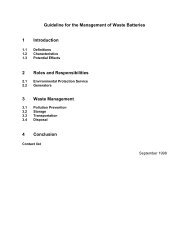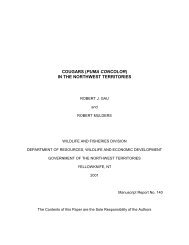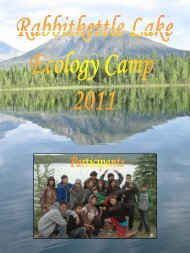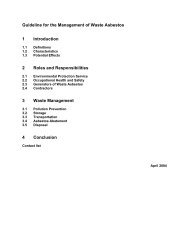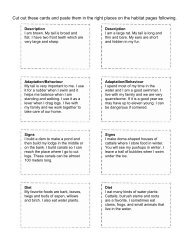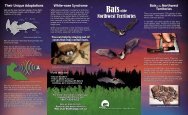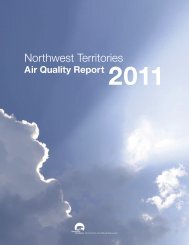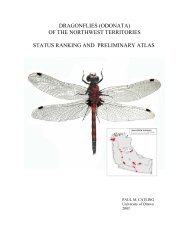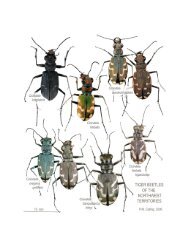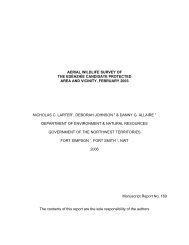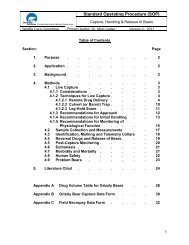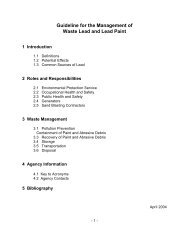2011 Annual Report of NWT Wildlife Research Permits and Western ...
2011 Annual Report of NWT Wildlife Research Permits and Western ...
2011 Annual Report of NWT Wildlife Research Permits and Western ...
Create successful ePaper yourself
Turn your PDF publications into a flip-book with our unique Google optimized e-Paper software.
<strong>Wildlife</strong> Species <strong>Research</strong>:<br />
Birds<br />
OBJECTIVES:<br />
´ ´ To evaluate the latitudinal variation in life history<br />
traits <strong>of</strong> yellow warblers;<br />
´ ´ To test the generality <strong>of</strong> winter habitat impacts<br />
on breeding success (“carry-over” effects)<br />
in neotropical songbirds by studying a species<br />
on the western flyway; <strong>and</strong><br />
´ ´ To determine whether there is a latitudinal impact<br />
on carry-over effects. It is expected that carry-over<br />
effects will be more pronounced for birds breeding<br />
in more northerly locations.<br />
METHODS:<br />
Breeding activities were monitored <strong>and</strong> feathers sampled<br />
at two locations in Canada: Revelstoke, BC <strong>and</strong> Inuvik,<br />
<strong>NWT</strong>. Data from Revelstoke was collected by team<br />
research technicians under the supervision <strong>of</strong> Dr. David<br />
Green. Breeding activities (date <strong>of</strong> first egg, clutch size,<br />
development periods, <strong>and</strong> number fledged) were<br />
monitored throughout the season at each site. The<br />
majority <strong>of</strong> all breeding adults were captured using mist<br />
nets. Each bird had st<strong>and</strong>ard body metrics taken, six<br />
feathers sampled–three greater covert (moulted on<br />
wintering grounds), two primary coverts <strong>and</strong> a single<br />
retrice (moulted on breeding grounds), <strong>and</strong> was colourb<strong>and</strong>ed<br />
for identification purposes. Nestlings were b<strong>and</strong>ed<br />
at seven days <strong>of</strong> age.<br />
RESULTS AND MAIN CONCLUSIONS:<br />
The first male yellow warbler arrived on our study site<br />
on 22 May. Males arrived over a 20 day period, with<br />
the majority arriving near the end <strong>of</strong> May. Females<br />
followed shortly thereafter. A total <strong>of</strong> 114 adults were<br />
caught throughout the season <strong>and</strong> were sexed, aged,<br />
measured <strong>and</strong> feather sampled. Of these, 90 adults were<br />
new captures <strong>and</strong> were newly b<strong>and</strong>ed. The earliest nest<br />
was initiated on May 26 <strong>and</strong> the last nest was predicted<br />
to fledge on July 28. Over the course <strong>of</strong> the breeding<br />
season we monitored 49 breeding pairs <strong>and</strong> located<br />
a total <strong>of</strong> 77 nests, 61 <strong>of</strong> which turned active with eggs.<br />
Average clutch size across all breeding attempts was<br />
4.2 eggs, incubation periods spanned 11 days, <strong>and</strong> young<br />
usually left nests after 9 days. Approximately 70% <strong>of</strong><br />
all breeding pairs successfully fledged young. Relative<br />
to the Revelstoke population, males arrived later, nests<br />
were initiated over a shorter time period <strong>and</strong> later in the<br />
season, clutch sizes were larger, development periods<br />
were similar <strong>and</strong> overall pair survival was higher in Inuvik.<br />
Yellow warblers breeding at high latitudes appear to have<br />
shifted some but not all life history traits towards<br />
a “fast” life history. Stable isotope data from <strong>2011</strong><br />
feather samples are currently being analyzed.<br />
LONG-TERM PLANS .<br />
AND RECOMMENDATIONS:<br />
This was the final year <strong>of</strong> a three year study <strong>of</strong> breeding<br />
ecology <strong>of</strong> yellow warblers in Inuvik, <strong>NWT</strong> (2009-<strong>2011</strong>).<br />
We plan to return during the 2012 season to resight<br />
b<strong>and</strong>ed individuals from previous breeding seasons.<br />
B<strong>and</strong> returns will allow for a better estimate <strong>of</strong> population<br />
survivorship. The Inuvik study sites appear to be important<br />
breeding sites for yellow warblers as they are high density,<br />
productive breeding grounds.<br />
COMMUNITY INVOLVEMENT:<br />
On 7 June <strong>2011</strong>, we presented our research to students<br />
enrolled in the Environment <strong>and</strong> Natural Resources<br />
Technology Program at Aurora College, <strong>and</strong> invited<br />
students to participate in our research. On 14 July <strong>2011</strong>,<br />
we provided a public presentation <strong>of</strong> our research<br />
proposal, methods <strong>and</strong> preliminary findings at the Aurora<br />
<strong>Research</strong> Institute. Throughout the season, we stayed in<br />
contact with the Gwich’in Renewable Resources Council<br />
<strong>and</strong> <strong>of</strong>fered to take on students to provide experience<br />
with bird i.d., nest monitoring <strong>and</strong> bird b<strong>and</strong>ing.<br />
35


